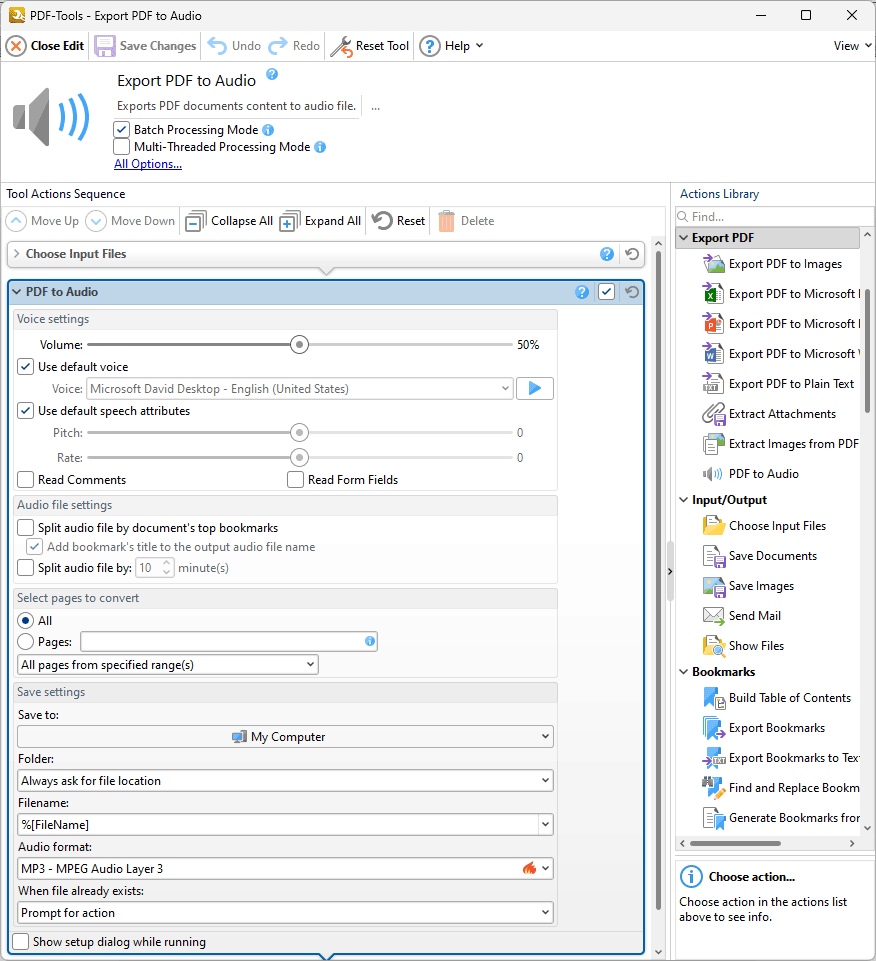 PDF to Audio
PDF to Audio
The PDF to Audio action copies text in PDF documents to audio file format. It contains the following customizable parameters:

Figure 1. Export PDF to Audio Action Options
•Use the Volume slider to determine the volume of the voice used in the audio file.
•If you do not want to use the default voice for the audio file, then clear the Use default voice box and select an alternative voice in the dropdown menu.
•Use the Pitch and Rate sliders to determine the pitch and speed of the voice used in the audio file.
•Select the Read Comments and/or Read Form Fields box to include the text of comments and form fields in the audio file. Text from comments and form fields is placed at the end of the audio file recording.
•Select the Split audio file by document's top bookmarks to split input documents into output documents according to the top bookmarks of the input document.
•Select the Split audio file by box to split input documents into output documents of the length specified in the dropdown menu. The default length is ten minutes. Use the dropdown menu to specify an alternative length as desired.
•Select All to convert the text from all pages.
•Select Pages to specify a page range for conversion. Information on how to specify page ranges is available here.
•Use the Save to dropdown menu to determine where output files are saved:
•Click My Computer to save files to the local computer.
•Hover over Add Place to add a new place at which to save files, then click Box.com, Dropbox, Google Drive, OneDrive or Sharepoint to add accounts from these locations. PDF-Tools will prompt for the login information for the selected account. When this information has been entered, the account will be detailed in the list and can be used to save files as desired.
•Use the Folder dropdown menu to determine where converted files are saved:
•Always ask for file location prompts the user to select a location each time the action is used.
•Use source folder as destination uses the source folder of input files as the save location.
•Use custom folder specified enables the user to specify a folder. If this option is used then the folder location must be specified in the text box beneath the dropdown menu.
•Use the Filename text box to name output files. The default name is defined by the macro %[Filename], which uses the name of the source file. Click the dropdown arrow to add additional macros.
•Use the Audio format dropdown menu to determine the format of the audio file. Click the settings icon to determine the Sample rate, Channels and/or Bitrate as desired.
•Use the When File Already Exists dropdown menu to determine the action taken when filenames are already in use:
•Prompt for action prompts the user for an action to take.
•Overwrite with a new file overwrites the existing file with the new file.
•Keep existing file unchanged retains the existing file and does not save the new file.
•Save new with other unique name inserts a prefix to the filename and then saves the new file.
•Select the Show setup dialog while running box to launch the PDF to Audio dialog box and customize settings each time this action is used. Clear this box to disable the PDF to Audio dialog box from opening each time the action is used, which is useful when the same settings are used consistently.
Click ![]() Save Changes to save changes.
Save Changes to save changes.
Note that it is necessary to have Media Foundation installed on the local machine for this action to operate, as detailed here.